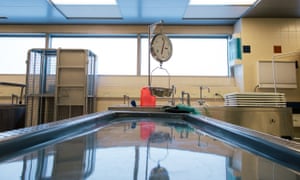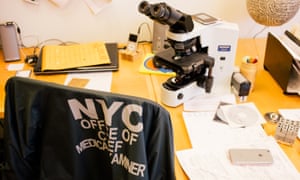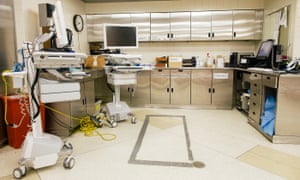The smell in the autopsy room is indescribable. It lingers on your clothes and in your hair long after you leave. Staff are constantly cleaning the linoleum floors and wiping down every surface with harsh disinfectants. But if anything, it adds to the uniquely acrid odor.
You never get used to the smell, says Jennifer Hammers, deputy chief medical examiner for Kings County, New York – but you do get beyond it.
I’ve been allowed a privileged glimpse at a regular Wednesday in the Brooklyn office of the Chief Medical Examiner of New York City. The office is one of the busiest of its kind in the country.
Around 70,000 people die in New York City each year, and about 8,000-9,000 of them end up at the medical examiner, requiring further investigation. Of those, 5,000 are autopsied.

Only the lonely
In the basement, the staff are hard at work in the autopsy suite, carefully examining the bodies and photographing relevant organs for their reports.
Most cases brought to the medical examiner are not crime related. In a city of over 8 million people, with many immigrants and transplants from other parts of the country, there is no shortage of the lonely.
Of the seven bodies brought in today, three have died alone in their apartments. In the summer, without air conditioning, it can take as little as two days before the smell of a body causes neighbors to make a call.
One gentleman found alone in his home is now lying before me on a steel gurney. James Daniels, a lead forensic mortuary technician, is carefully removing the scalp before cutting the skull with a bone saw so the brain can be examined for any signs of aneurysm, stroke or other potential causes of death.

Over 60 forensic mortuary technicians like Daniels work in New York City. While the 31 medical examiners in New York City are all highly trained physicians who completed special fellowships, technicians don’t have any educational requirements.
Typically, technicians join when they are young and only have a high school education. They learn the intricacies of their job on site. Without them, the office would cease to function. They are the ones dispatched to collect the bodies for autopsy. They are often the first people from the office a family encounters when grieving.
Being the doctor’s doctor
In addition to the medical examiners, there are x-ray technicians who scan for bullets and broken bones; DNA and toxicology laboratory staff; consulting dentists for matching dental records for identification; anthropologists who specialize in discovering the race, age and height of skeletal remains and figuring out what tools caused blunt force traumas; mortuary technicians who assist with autopsies; a variety of administrators; death scene investigators; and professional photographers who take careful photos of every autopsy for detailed record keeping.
One of the photographers on staff also takes professional photos of food, Hammers tells me with a smile.
While the doctors examine the body and determine the cause of death, the technicians do a lot of careful and very skilled cutting to assist them. They also clean the bodies after the autopsy is completed, making sure that it is in a pristine state when handed over to a funeral director.
For Daniels, who started with the Office of the Chief Medical Examiner as a young man in 1989, it was an unexpected career choice, as he hated the idea of being around dead bodies and avoided funerals entirely.
Most of the medical examiners, on the other hand, said they always loved the idea of solving a mystery, of being “the doctor’s doctor”. They wanted to be the ones to determine the real cause of a death or diagnose a pathology.

Daniels had a more pragmatic reason for joining the office: he needed a job, and working for the city meant stable employment. When he first started, he dreaded touching bodies and entering strangers’ homes. It was fear of the unknown, he explains. But these days, working as a lead technician, there is little left unknown when it comes to the dead.
Daniels was on the job during 9/11. He also responded to Flight 587, which crashed in Queens in November 2011, killing everyone on board. That time created his worst memories of the job. But it also gave him the greatest sense of the work’s importance: none of those families would otherwise have had closure. He now “loves the job”, he says.
The case that hits home
No matter how long they have been working at the Office of the Chief Medical Examiner, and how many bodies they have seen, everyone has a case that hits home.
For Barbara Sampson, the chief medical examiner for New York City, it was a 9/11 case. The terror attack on 9/11, which Sampson refers to as the biggest homicide in US history, was a difficult time for all of the staff at the office. They worked round the clock to identify bodies, and the images they saw still haunt most of them fifteen years later.
Identification often had to be done from DNA analysis of fragments of remains and is still ongoing as new DNA techniques are discovered.
One particular case sticks out for Sampson: a Belgian man who died during the collapse of the World Trade Center towers. His parents were elderly, and while they knew that he had died, without official scientific confirmation, they could not get closure. His remains had not been identified. They were afraid they would pass away never having his death confirmed.
Two years ago, Sampson’s office was able to identify the Belgian man’s remains through DNA analysis. “I had the honor of telling them we had found their son. That was one of the most incredible experiences of my life,” she says. Thirteen years after 9/11, the parents could finally put their son to rest.

For Aglae Charlot, an elegant senior medical examiner with a pronounced French accent who has worked at the office since 1987, it was a teenage girl who came in a few years back. The girl died in the hospital of an unusual illness, from which her mother also suffered. The illness can be idiopathic or caused by Aids. The hospital had assumed it was idiopathic since the mother had the same illness.
When Charlot investigated, she found the teenager did actually have Aids, which she must have been suffering from for five or six years.
Upon further investigation, she discovered the mother’s boyfriend had died of Aids.
Infecting a child and causing her death is murder, she explains to me, her jaw tensing. Charlot knew she could probably trace the particular strain of Aids back to the boyfriend, but what would it change? He was dead, so could not be charged, and it would only cause more pain for the living. She put Aids as the cause of death on the certificate, and left it at that.
Seeing the lighter side
“We all have an odd sense of humor,” says Christopher Brock, a bearded young medical examiner sitting in front of a file cabinet covered by photos of his wife and two young children. “We are often smiling, and I think you have to when you are surrounded by this every day.”
In Hammers’s office, her crooked playfulness is on display in a framed, fake blood-spattered sign above her desk that reads: “Braainns.”
Humor can provide a release in an environment that is fraught with stress. “One of the things a lot of people don’t realize is that we deal with the living just as much as we deal with the dead,” says Brock. “We provide answers to families.”

Much of the week is spent performing autopsies, and the rest of it filling out paperwork, testifying in court and speaking with the families of the dead.
At a time when primary care physicians rarely have more than two minutes to speak with a living patient, it’s strange somehow that the medical examiners can spend hours explaining their findings to the families, comforting them and helping them deal with their grief.
“Every family really wants to know what happened to their loved one and have their questions answered in order to have closure,” says Hammers. “Even if it is a hard answer like in the case of a suicide, it wouldn’t be what they prefer to hear but it allows them to have an answer and then work their grief around that and move through it.”
As Brock puts it, when it comes to the deceased: “We are their last physicians.”
Brains and bone saws: a day with the chief medical examiner of New York City
Hiç yorum yok:
Yorum Gönder